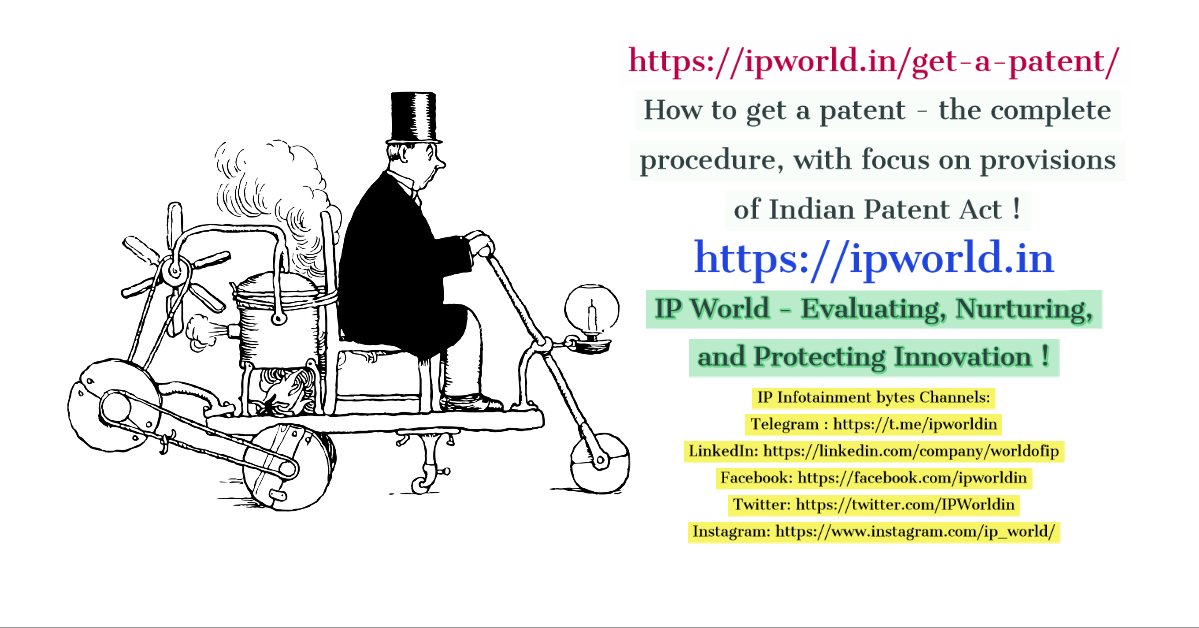How to get a patent is a vexing question for most inventors. While one can find much information on the Net pertaining to the subject, a comprehensive guide is lacking, particularly with reference to Indian perspective. Hence it is hoped this article will be very useful.
If you are unfamiliar with Intellectual Property as such, of which patenting is a subset, kindly see : What is Intellectual Property .
And those unfamiliar with what is a patent to begin with, this post maybe helpful.
This article is written from perspective of an Inventor ( or a Patent Filing Entity – PFE ) using a Patent Agent (PA). The inventor need not be the PFE since he/she can assign his/her invention to the PFE. The inventor can be more than one persons. Similarly the PFE can in turn be an individual, a group of individuals, or an entity such as a firm, educational institute etc. Likewise, the PA can be an individual or, more usually,a firm.
It is not at all necessary to use a PA and an inventor can file a patent application direct with the Indian Patent Office (IPO) . Indeed many do. However this course is not advisable for any seriously interested in claiming rights on his/her invention since the procedure has many fine points that need to be well-understood and deadliness that need to be well-monitored. Generally, only a PA who does this day in and day out can do this with properly as the PA has appropriate infrastructure and manpower for the same.
In short, the complete procedure has the following steps:
- Signing the Non-Disclosure Agreement: A Non-Disclosure Agreement (NDA) is signed between the PA ( interchangeably termed as the Firm herein) and the PFE ( entity desirous of filing the Application and getting a patent granted on same ). The purpose is to assure the PFE that any information provided by the PFE to the Firm will remain confidential and used only for the purpose of preparing the patent application.
- Disclosing the Invention: The PFE discloses all aspects of the Invention to the Firm including diagrams, exemplary analysis and results thereupon etc. Particular focus is to be given to aspects the PFE considers novel and inventive. An Invention Disclosure Form (IDF) may be provided by the Firm to the PFE to structure the process.
- Prior Art Search: Upon instruction by the PFE, the Firm conducts a Prior Art Search to prima facie establish if the Invention as disclosed by the PFE is indeed novel and inventive. The search is conducted using a team of expert prior art searching professionals. Various databases, articles, websites, theses etc. are scanned for the purpose and a Patentability Search Report (PSR) is sent by the Firm to the PFE.
While the Prior Art Search is not an essential step for preparing and filing a patent application ( since the IPO also does its own search as part of the grant procedure ) it is strongly recommended to enable the PFE have a clearer understanding of patentability of its invention and take further steps accordingly. A prior art search may take anywhere between one week to a month, depending upon the invention and the present workload of the Firm. - Preparing the Specification: Upon appropriate instructions from the PFE, the Firm proceeds to draft the specification based upon the IDF and consequent PSR (if prepared). The specification is a techno-legal document crafted by professionals in the field in accordance with the IPO requirements. It can either be a ‘provisional specification’ or a ‘complete specification’, the difference between the two being primarily in the ‘claims’ section that is added in the complete specification. The purpose of the provisional specification ( and correspondingly, a provisional application filing ) is for the PFE to reserve an early ‘priority date’ since any other patent application similar to that filed by the PFE but after the priority date may not be granted a patent, depending upon the specifics of the case. However, the provisional and the complete specifications have to be substantially same and focusing on same inventive matter, if the priority date of the provisional application has to be held. Minor changes, such as improved results by varying ranges of some reagents, additional embodiments not elaborated in the provisional specification but having the same underlying inventive concept etc. can be brought out in the complete specification.
A specification takes about 10-20 days’ time, depending upon the project pipeline at the instant with the Firm. - Filing the Application: The patent application (with either the provisional specification or the complete specification, termed as provisional application or complete application accordingly) is filed by the Firm electronically. The docketing department of the Firm takes care of this aspect. Usual documents for the same are as under. These maybe asked from the PFE, provided by the application drafter, or filled up by the Docketing Team under instructions from the PFE as appropriate. The date of filing of the provisional application is the ‘priority date’. However, if a complete application is straightaway filed, such date of filing is the priority date. In case a provisional application is filed first, the the complete application has to be filed within twelve months of the provisional application otherwise the application is deemed as abandoned.
- Filing can be via Indian Patent Application filing route or via the Patent Cooperation Treaty route (PCT). Documents needed for the former are as under:
- Simply signed power of authority by the PFE.
- A declaration signed by the inventor(s) or a notarized copy of the assignment from the inventor(s) to the applicant(s) ( applicant(s) being the PFE).
- Copy of the provisional or the complete specification as the case maybe (including, for the complete specification, description, claims, abstract of the disclosure, and drawings if any) in English, typed or printed with reasonable clarity,
- Name and address of the applicant, together with the number(s), place(s), and date(s) of the basic application(s) if convention priority is claimed.
- Multiple priority documents need to be supplied if applicable.
The application form among other statements and undertakings are completed by the Firm.
- Application filing under Patent Cooperation Treaty (PCT ) : For an application earlier filed under PCT and now intended to be filed in India for proceeding to a National Phase Application in India, at least identifying particulars of the PCT application are required to proceed into the National Phase, along with necessary power of attorney for the Firm. A verified English translation, if necessary, should also be provided before the deadline, 31 months after the priority date along with the instrument of assignment or transfer where the applicant is not the inventor. Only a complete specification can be filed under the PCT route.
- Publication of the Application: If no request for early publication is received, the complete patent application is published by the IPO upon completion of 18 months from the priority date. It should be noted that at this stage only the complete application (carrying complete specification) is published. As already said, in case a provisional application has been filed, the complete application has to be filed within twelve months of the provisional application otherwise the application is deemed as abandoned. A request for early publication (RFP) may be made to the IPO if the PFE wants to expedite the patent grant procedure. Upon publication the complete application is publicly available at the IPO Website.
- Examination of the complete application: For this step to proceed, a Request for Examination (RFE) has to be made to the IPO. It may be made along with RFP. However, a Patent Examiner of the IPO proceeds with an examination only after the complete application is published. An RFE can be made within 48 months from date of filing (priority date) and if not made within such time, the patent application is deemed as abandoned.
- Responding to objections in the examination report(s): Upon examination, the patent office generates examination reports termed as First Examination Report (FER), Second Examination Report (SER) etc. as the case may be. Typically, these contain the Patent Examiner’s objections, usually citing some prior art found by him, as to why the subject patent application may not be granted a patent. The reports are communicated to the Firm by the IPO. In consultation with the PFE, the Firm responds to the examination reports within timelines as legally mandated. Within boundaries of the specification as filed, the Firm attempts to show to the IPO that the invention as described in the complete specification satisfies the criteria of patentability and so should be granted a patent. Personal/ video hearings may also be resorted to between the Controller of Patents ( of the IPO) and the Firm during this phase. The Claims of the specification may be modified in this phase (as long as they are within boundaries of description of the invention provided in the complete specifications) to meet the objections of the Controller.
- Grant of Patent: Upon the Controller of Patents being satisfied that the invention satisfies the criteria of patentability, the Controller puts the application ‘in order for grant’ of a patent. A patent certificate is accordingly issued thereafter. The grant of patent is notified in the patent journal published from time to time.
- Renewal of Patent Fees: A patent is granted for twenty years from its ‘priority date’, provided renewal fees are paid in a timely manner.
All the examination steps and communications for same until grant/rejection of patent are also made publicly available at the Patent Office at its Website, along with Provisional Application if any filed.
Above is a simple explanation of patent application filing and grant procedure at Indian Patent Office and holds under most situations.
Exceptions and specific situations will need to be analyzed and specifcially discussed.
I hope above helps all the budding inventors navigate the patenting landscape in India.
Please see the page as under to contact us regarding this Website as well as for any of your Intellectual Property related queries such as pertaining to Patents, Trademarks, Copyrights, Industrial Designs etc . Thank you.
https://ipworld.in/contact-me/
Find IP Infotainment bytes also via:
Telegram : https://t.me/ipworldin
LinkedIn: https://linkedin.com/company/worldofip
Facebook: https://facebook.com/ipworldin
Twitter: https://twitter.com/IPWorldin
Instagram: https://www.instagram.com/ip_world/


One thought on “How to get a patent”